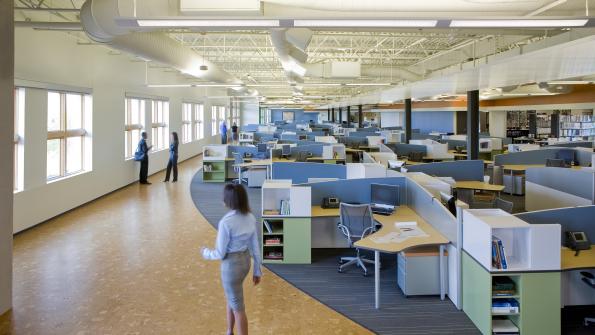Acoustical challenges in green buildings (with related video)
Post-occupancy evaluations conducted by the Center for the Built Environment reveal that green building acoustics are typically worse than their traditional counterparts, and that over half of respondents feel noise inhibits their work.
Though the U.S. Green Building Council now offers LEED® points for acoustics in Commercial Interiors and New Construction (V4, EQc9), it is important to understand how to address the issues that can arise in government buildings from some of the most common green design strategies.
Planning an open ceiling?
Ensure this decision will have the desired benefits (e.g., efficient heating/cooling), because removing the tile eliminates the largest source of absorption in a space. If an exposed structure is still desired, treat a percentage of the deck with an absorptive material or install vertical baffles. Build walls to the deck and ensure they have a high Sound Transmission Class (STC) rating, which prevents airborne noise transmission. Facility managers should ensure that the STC rating of doors and interior windows at least meets the wall standard.
Promoting daylighting?
If the space is narrow in order to promote light penetration, use absorptive wall panels to prevent noise from ricocheting between the exterior wall and the core. Rather than employing open benching, use absorptive workstation partitions that rise to 48 inches and are topped with a further 12 inches of glass; these provide the physical barrier needed between close neighbors while not impeding daylighting. Ensure panels have a high STC rating and are well-sealed along any joints, with no significant openings between or below them; these requirements also apply to demountable wall systems.
Using alternative ventilation?
The background sound level in most conventional offices is already too low. The use of high-efficiency heating and cooling systems means that it is generally even lower in green buildings. As a result, conversations and noises can easily be heard. Install a sound masking system, which will maintain the background sound level at an appropriate volume. It will increase speech privacy and reduce the disruptive impact of noises, either by covering them up completely or by decreasing the amount of change between the baseline volume in the space and any peaks.
Using a sound masking system can also help support other sustainable endeavors, especially when included in a project’s design phase. For instance, masking increases noise isolation in open areas. It can also enhance the performance of demountable wall systems, contributing to the space’s flexibility and reducing waste following future renovations.
About the author 
Niklas Moeller (pictured at the right) is vice-president of K.R. Moeller Associates Ltd., a global developer and manufacturer of the sound masking system, LogiSon Acoustic Network. K.R. Moeller Associates is headquartered in Burlington, Ontario. The author can be reached at [email protected].
Go here for the first part of this series, which tells how to specify sound masking in facilities.
Go here for the second part of this series, which tells how to achieve effective acoustics in facilities.
This video shows how Sustainable Series acoustical products from Acoustical Solutions, Inc. help facility managers and developers meet green building standards and earn LEED points on building projects.
_____________
To get connected and stay up-to-date with similar content from American City & County:
Like us on Facebook
Follow us on Twitter
Watch us on Youtube




















